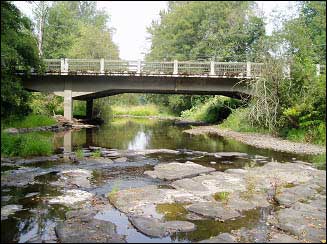















Successes in Stewardship: September 2004 |
|---|

|
Federal Highway Administration
September 2004
Bridging Multiple Objectives: The Oregon Major Bridge Replacement Program

The large scope of its statewide Bridge Replacement Program enables Oregon to utilize economies of scale to improve efficiency and apply context-sensitive and sustainable solutions.
In 2003, when the Oregon State legislature authorized $1.3 billion for the replacement or repair of more than 350 aging bridges over the next decade, it was clear that the Oregon Department of Transportation (ODOT) faced a huge challenge. However, to some at ODOT it was also apparent that this challenge presented enormous opportunities. They recognized that only a programmatic and context-sensitive approach would enable the State to deliver this ambitious program within the mandated timeframe and in keeping with ODOT's environmental goals.
In the past year, ODOT has leveraged the magnitude of the bridge replacement program to capture economies of scale and to achieve environmental stewardship and streamlining goals. Recently launched initiatives include the early collection and compilation of environmental data for a statewide Geographic Information Systems (GIS) database, the development of performance standards, and a programmatic approach to permitting and mitigation banking.
The Oregon Bridge Replacement Program has fostered a new approach to doing business that fully integrates environmental stewardship and streamlining into planning, design, and construction. This approach — which applies ODOT's "CS3" philosophy of Context-Sensitive and Sustainable Solutions — includes the following initiatives:
|
Context-Sensitive Solutions and Public Involvement The Bridge Replacement Program is the largest public investment in transportation in Oregon since World War II. As such, it provides an unprecedented opportunity to create an integrated design signature across the State. Aesthetic design packages called "palettes" offer local communities a range of treatment options. Local Area Commissions on Transportation (advisory bodies chartered under the Oregon Transportation Commission) determine what bridge type is most appropriate for their area. Public outreach meetings will also address other issues, such as construction scheduling and ways to minimize impact on local businesses. |
ODOT staff estimate that their environmental stewardship and streamlining efforts will produce a 10-percent reduction in program delivery cost. Foremost among these efforts is avoiding the "design and defend" mentality, which typically leads to iterative redesign. In the past, redesigning their way out of environmental conflict could add as much as 30 percent to initial costs; getting the design right the first time will save significant resources. Additional savings are expected through the programmatic approach to permitting. ODOT predicts that environmental permitting costs for a typical bridge will drop from around $100,000 to around $70,000. Most concretely, ODOT has already shaved two years off of the construction schedule.
In terms of the program's contribution to environmental sustainability and stewardship, ODOT staff cite gains such as better impact avoidance and minimization through context statements and baseline reports, environmental enhancement through green bridge design standards, community satisfaction through public involvement and design choice, and more significant mitigation through mitigation banks.
The legacy and transferability of the program also speak to its worth. Previously, financial constraints necessitated that ODOT operate in a project-by-project manner, and the agency was not able to develop statewide environmental GIS or a comprehensive approach to mitigation banking. But the large scale of the Bridge Replacement Program has endowed ODOT with a critical mass of funding that enables its new comprehensive approach. In addition, improved relations with permitting agencies are expected to provide lasting value in both the cost and tenor of future environmental negotiations.
An important lesson learned from the Bridge Replacement Program is that environmental streamlining and stewardship must begin at home. According to one ODOT official, "if we have had any success it is because ODOT imposed streamlining on themselves before imposing it on other agencies." Similarly, ODOT staff emphasize the importance of understanding and accommodating the missions of resource agencies.
See http://www.odot.state.or.us/otia/otia3index.htm and http://odotbridgesee.org for more information.
|
|
